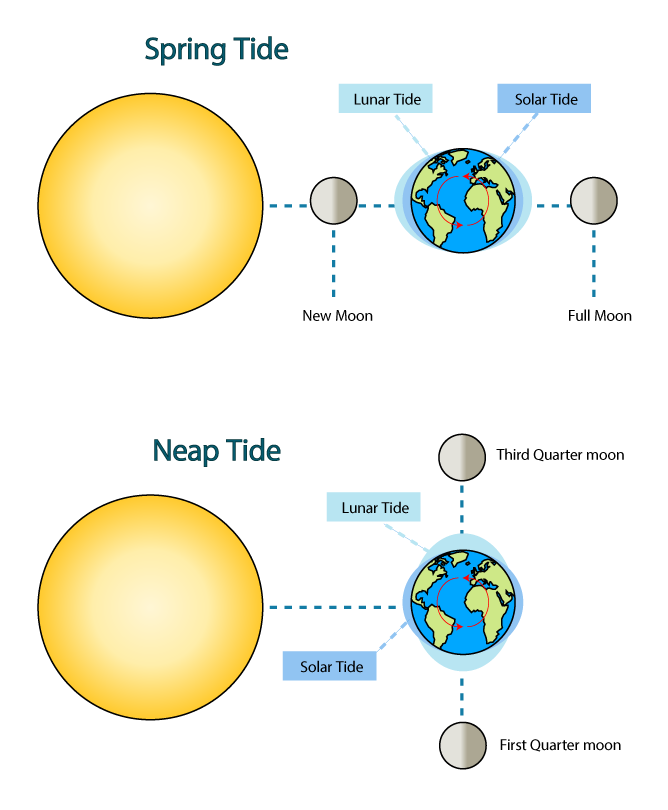

Something you will definitely become an expert on if you live in a place affected by tides is how the sun and moon affect the tide and how the tide actually works. This is absolutely vital to understand if you are to keep yourself safe but also get the most out of your sessions. Timing a session right as regards the movement of the tide can be the difference between an epic session and a session spent sunbathing.
What is Tidal Range?
Tidal range is defined as the difference (in meters) between the low tide mark and the high tide mark. Thus if you have a low, low tide and a high, high tide, the tidal range will be great, conversely, if you have a high, low tide and a corresponding low, high tide, the tidal range will be small.
Tidal range is controlled by the alignment of the sun and the moon. When the sun and moon come into alignment as happens twice a month then all the gravitation pull aligns in the same direction. This has the effect of sucking all the water on earth into the middle of the globe. As water cannot sit only on one side of the earth it is balanced on the other side of the world.
High, High Tides
As the earth rotates this bulge of water moves around the earth creating high, high tides as land masses encounter the ‘bulge’ and low – low tides when the bulge moves on. This alignment happens when ever there is a full or a new moon as at these times the sun and moon are aligned. It doesn’t matter if the sun and moon are on the same side of the earth or on opposite sides because the water has to be balanced on both sides of the earth the gravitation fields still align.
Low, Low Tides
Conversely when the sun and moon are out of alignment the tides will be significantly less as the water of the earths oceans will be distributed around the earth in a more even manner. This is seen most when the sun and moon are completely out of alignment or at right angles to each other, ie when we have a half moon, at this point the gravitation fields are pulling at right angles to each other so the earths water is distributed more evenly over the surface and we get correspondingly little tidal range, with high, low tides and low, high tides.

Spring & Neap Tides
These 2 events are referred to as Spring and Neap tides. Spring tides occurring at Full and New moons and causing high tidal ranges, and Neap tides occurring at Half moons and causing small tidal ranges. Because of the momentum like effect of gravity there is a slight delay of around 2 – 3 days between the moon state and the corresponding effect. Ie you will get a Spring tide roughly 2 -3 days after a Full or New moon.
Using this information you can accurately predict how high a tide is going to be on a particular day. In places with little tidal effect this may not be so important in other places (estuaries for example) this may be of huge importance and mean a difference of miles between high or low tide water marks.
The Rule Of 12ths
The rule of 12ths tells us (roughly) the amount of water that will be moving, either in our out, at any stage in the tidal cycle of a semi diurnal (twice daily) tide.
Starting at Low tide and moving towards High tide:
In the 1st hour after a low tide we experience what is called slack water. This is Where the tide isn’t really moving and thus not much water is flowing. A small amount of water will however be pushing up the beach. In this hour 1/12th of the total volume of water that is going to move as the tide comes in will move.
In the 2nd hour the flow of water will increase and speed up, during this hour 2/12ths of the total volume of water that will move with the incoming tide will move.
In the 3rd and 4th hours the tide really picks up speed and a huge volume of water will move. During each of these hours 3/12th of the total volume will move. So thats half the total volume of water in these 2 hours.
In the 5th hour the flow of water will start to slow again as the tide gets nearer to its highest mark, In this hour 2/ths of the total volume of water will flow.
In the 6th and final hour of the tide, the tide has more or less reached high tide and has entered the phase known as slack water again. In this hour only 1/12 th of the total volume will flow.
From here on the tide follows the same pattern but this time the water is flowing out.
The Time To Care
This information can again be critical in certain locations. The 3rd and 4th hour should be treated with a little respect anywhere where there is significant tide as a huge amount of water is flowing and it is flowing fast. This can have a huge effect on your safety, your ability to practice and the distance you have to walk to get back to the car.
It is beyond the scope of what I’m covering today to go into specifics of conditions that can be found at every single spot. That said you need to know if there are any particular hazards you should be looking out for, check with someone who knows about these things, kitesurfers, windsurfers, surfers, fishermen will all have a good idea of what you need to look out for.
Remember the sea is a big old girl and needs to be treated with respect.